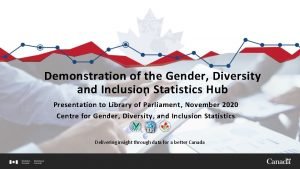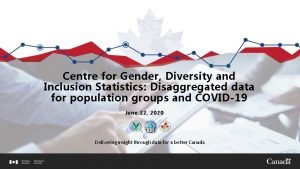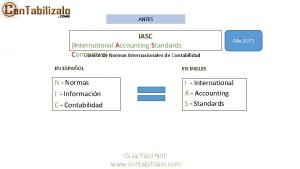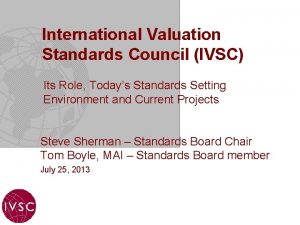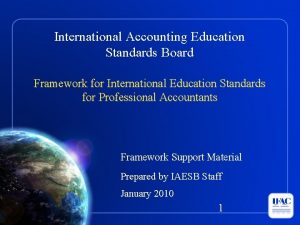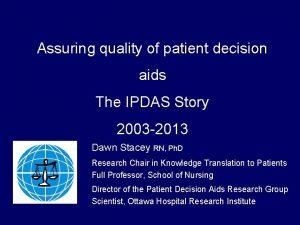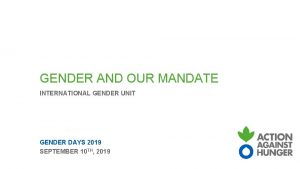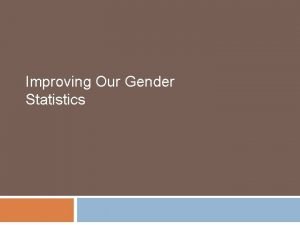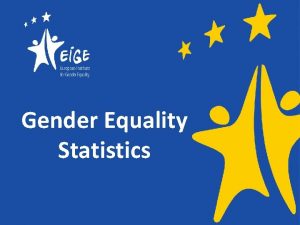New international standards for gender statistics in paid


















- Slides: 18


New international standards for gender statistics in paid and unpaid work Part I: International standards setting Part II: Concepts and definitions Ø Framework forms of work Ø Labour Force and measures of labour underutilization Gender mainstreaming in work and labour statistics Part III: Conclusion and ways forward Tinonin, Cecilia ILO

International standards o International standards relate to concepts, definitions, classification and other methodological procedures agreed to representing best practices o International standards aim at: • Increase the likelihood of having international comparable statistics • Comparability across time within a country o In the area of measuring unpaid care and domestic work, there is a great need for enhancing international comparability through the provision of common concepts, definitions and methods • Time Use and the SDG 5. 4. 1 Tinonin, Cecilia ILO

International Conference of Labour Statisticians (ICLS) o ICLS is the world’s recognized standard setting body in the area of labour statistics o Since 1923, it is convened roughly every five years by ILO o It is composed of experts from Government, employers’ and workers’ organizations o It is invited to make recommendations in the forms of resolutions and guidelines. Tradition is that decisions at ICLS are taken by consensus Tinonin, Cecilia ILO

First international statistical definition of Work “Any activity performed by persons of any sex and age to produce goods or provide services for use by others or for own use” Para 6, Resol I. (19 th ICLS, 2013) Tinonin, Cecilia ILO

Work and the System of National Accounts Activities Nonproductive activities Sleeping Learning Own-recreation Begging Stealing Productive activities Non-market Market units Households units Incorporated, producing for own final use Service s Government, Non-profit institutions Goods ed d lu c In Service s Goods unincorporated Service s Goods Previous activity scope for “employment” New concept of “Work” == productive activities General SNA productio n n boundary Tinonin, Cecilia ILO

Illustration: Own use providers of services by sex and activity cluster (%WAP) Most unpaid household services predominantly performed by women, except for household repairs Source: ILO calculations based on national data (LFSCWIQ, 2010) Tinonin, Cecilia ILO

Forms of Work Framework: By main intended destination & transaction type Work (i. e. ALL activities to produce goods and services) For own final use (by households) Own-use production work Service Good s s For use by others (i. e. other units) For remuneration (i. e. for pay or Without remuneration profit) Reference concept for Labour Force statistics Unpaid trainee (work for pay or profit) work Employment Service s Good s S G Other work activities (e. g. unpaid compulsor y. Swork) G Volunte er work G S SNA labour input Tinonin, Cecilia ILO

Illustration: Measurement of participation in different forms of work becomes possible Source: ILO calculations based on national data (LFSCWIQ, 2010) Tinonin, Cecilia ILO

By Labour Force Above minimum age. . . : ALL who work for pay ALL who work for profit -Employers -Own account workers in market units -Contributing family workers -Members of market producer cooperatives ALL OTHERS > age, whether or not: -Provide services for own final use -Volunteer providing services for households -Work unpaid for training -Produce goods for own final use -Volunteer through / for organizations -Volunteer producing goods for households Without employment (for pay/profit) Seeking and available for work for Ye No pay/profit Outside the s Persons in employment (work for pay / profit) Unemployed Labour force Underutilized labour (with unmet need for employment (for pay/profit) labour force Tinonin, Cecilia ILO

Labour force & labour underutilization Improved labour market monitoring across contexts Working age population Labour force Employed (for pay/profit) Time-related underemploy ed Unemploye d Outside the labour force Potential Labour Force -seeking, not available -available, not seeking Labour underutilization (unmet need for employment) Want employment but not seeking, not available Do not want employment Tinonin, Cecilia ILO

Illustration: Willing non-job seekers Percentage of willing non-job seekers among persons outside the labour force (%) Source: Enquête nationale sur l’Emploi, Morocco 2012 Tinonin, Cecilia ILO

Main reason for not being in labour market Personal reasons Own illness, disability Studies, training Family related reasons Pregnancy, family or household responsibilities Refusal by family Social barriers Labour market reasons Past failure in finding a job, gave up looking for jobs Lack of experience, qualifications or jobs matching skills Lack of jobs in the area Considered too young or too old by prospective employers Discouragement Lack of infrastructure No roads, transport, employment services in the area Other sources of income Pensions, rents Tinonin, Cecilia ILO

Conclusion on the 19 th ICLS Resolution I Tinonin, Cecilia ILO

ILO LFS methodological programme Objectives & approach To develop evidence-based guidance Based on existing national practice Aligned with new standards Modular approach to support flexible implementation Volunte er work LFS Expected outputs LFS toolkit Module design (PAPI & CAPI) Explanatory notes Survey design requirements National adaptation guidance Indicator computation guidance Ownuse provisio n of services … Own-use producti on of goods Tinonin, Cecilia ILO

Ways forward Topic coverage Overall methodology Phase 1: 2015 -2017 Pilot studies o Employment o Qualitative phase o Labour underutilization o Own-use production work (stylized retrospective questions) • Cognitive interviewing o Operational phase • Small scale field tests o Statistical phase Phase 2: 2018 o Volunteer Work o Own-use provision of services o Labour Force in multipurpose household surveys • Split sample experimental designs Implementation partners o NSOs o Partner agencies (UN Volunteers, World Bank, FAO) o Development partners (Data 2 X) Tinonin, Cecilia ILO

Resources and Contact 19 th International Conference of Labour Statisticians http: //www. ilo. org/19 thicls 20 th International Conference of Labour Statisticians https: //www. ilo. org/global/statistics-and-databases/meetings-and-events/international-conference -of-labour-statisticians/20/lang--en/index. htm ICLS Resolutions and Guidelines http: //www. ilo. org/global/statistics-and databases/standards-and-guidelines/ ILO LFS pilot studies programme http: //www. ilo. org/stat/Areasofwork/Standards/lfs/lang--en/index. htm STATISTICS contact statistics@ilo. org Tinonin, Cecilia ILO

Thank you! Tinonin, Cecilia ILO
 Strategic gender needs and practical gender needs
Strategic gender needs and practical gender needs Centre for gender diversity and inclusion statistics
Centre for gender diversity and inclusion statistics Centre for gender diversity and inclusion statistics
Centre for gender diversity and inclusion statistics Introduction to statistics what is statistics
Introduction to statistics what is statistics Factors necessary for appropriate service standards
Factors necessary for appropriate service standards International property measurement standards
International property measurement standards International construction measurement standards
International construction measurement standards Copyright international color consortium, 2009
Copyright international color consortium, 2009 International standards on drug use prevention
International standards on drug use prevention Worldwide accounting diversity
Worldwide accounting diversity Contabilizalo.com
Contabilizalo.com International accounting standards ias
International accounting standards ias International valuation standards council
International valuation standards council International financial reporting standards 9
International financial reporting standards 9 International accounting education standards board
International accounting education standards board Ipdas
Ipdas Fspos vägledning för kontinuitetshantering
Fspos vägledning för kontinuitetshantering Typiska novell drag
Typiska novell drag Nationell inriktning för artificiell intelligens
Nationell inriktning för artificiell intelligens

